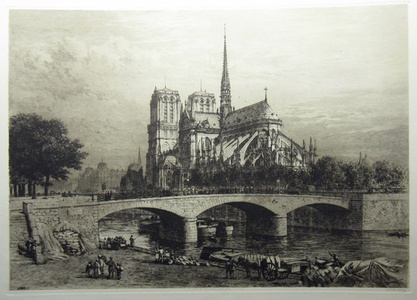| Method | Etching and aquatint |
| Artist | Axel Haig |
| Published | 1900 |
| Dimensions | Image 562 x 808 mm, Plate 606 x 800 mm, Sheet 675 x 985 mm |
| Notes |
Signed and inscribed in pencil by the artist. A magnificent and atmospheric print of Notre Dame, Paris. The scene shows the back of Notre Dame, the impressive flying buttresses seen supporting the cathedral walls serving as a prime example of Gothic architecture. In the very foreground there are small groups of people and horses and carts working on the banks of the river Seine. There are barges on the river, floating underneath Pont de l'Archevêché. Axel Herman Haig (1835 - 1921) was an architect, illustrator, and etcher whose work within the Gothic Revival led to him becoming one of the most noted architectural draughtsmen in Britain. Born on the island of Gotland, Sweden, Haig apprenticed as a shipbuilder at Karlskrona before further training in Glasgow for Clydeside shipbuilders. However by 1859 he had turned to architecture and proceeded to train as a architectural artist. Haig met eminent Victorian architect William Burges in 1866 and proceeded to work with Burges until his death in 1881. Haig and Burges were at the forefront of the Victorian Gothic Revival being involved in the designs of Cardiff Castle, Church of Christ the Consoler at Skelton-on-Ure, Castell Coch, and the redecoration of St. Paul's Cathedral. Haig later went on to become a hugely popular etcher known for his impressive and detailed prints of European architecture and he went on to become a member of the Royal Society of Painter-Etchers. Haig created over four hundred etchings through his life, the majority depicting castles, towers and cathedrals in both England and in Europe. Lennox-Boyd 163 Ex. Col.: Christopher Lennox-Boyd (Co-author of the catalogue raisonne of Axel Haig's printed works: Axel Haig and the Victorian Vision of the Middle Ages, Allen & Unwin, London, 1984) Condition: Some minor foxing to sheet. |
| Framing | unmounted |
| Price | £1,000.00 |
| Stock ID | 11867 |

